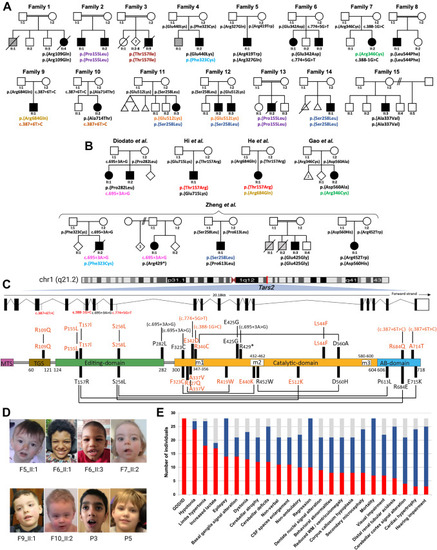Fig. 1
- ID
- ZDB-FIG-240206-21
- Publication
- Accogli et al., 2023 - Clinical, neuroradiological and molecular characterization of mitochondrial threonyl-tRNA-synthetase (TARS2)-related disorder
- Other Figures
- All Figure Page
- Back to All Figure Page
|
Clinical summary of individuals with biallelic TARS2 variants. Pedigree of families 1-15 (A) and previously reported individuals (B). Genotypes of tested individuals are indicated under the symbols. Variants observed in more than 1 family have been shown in different colors. In the pedigree, squares represent males, circles represent females, black shaded symbols denote affected individuals harboring biallelic TARS2 variants, and the gray shaded symbol refer to individuals presumably affected by the same disorder yet not tested. C. Schematic depiction of TARS2 transcript (ENSG00000143374) and the modular human mitochondrial threonyl-tRNA synthetase (TARS2) protein (ENSP00000358060) with localization of the disease associated variants. The different functional domains are shown to scale, named, and colored. MTS and AB stand for mitochondrial targeting sequence and anticodon-binding, respectively. m1, m2, and m3 are catalytic motifs 1, 2, and 3, respectively. Missense variants are indicated in red for those reported in the present study and in black for those reported elsewhere. Allelic compositions, as identified in individuals, are linked through black lines. Variants that do not lead to missense variants are indicated in brackets (because they correspond to genomic modifications). Although amino acid conversion of a given mutation is generally preceded by the letter “p.,” this is omitted for sake of simplicity. D. Clinical features of individuals with biallelic TARS2 variants. Subtle and non-specific dysmorphic features are indicated, such as thin upper lip vermilion in individual II:1 of family 5; mild coarse facial features in individuals II:1 and II:3 of family 6; short nose, long philtrum, and thin upper lip vermilion in individual II:2 of family 7; left eye strabismus and right uplifted earlobe in individual II:1 of family 9; broad and prominent forehead, sparse eyebrows, infraorbital creases, thin upper lip vermilion, and dimple chin in patient II:2 of family 10; thick eyebrows in individual 3; and deep set eyes in individual 5 previously reported by Zheng et al.11,12 E. Phenotypic bar graph showing the most relevant clinical and radiological features among all individuals so far identified with biallelic TARS2 variants. Red: number of individuals out of 28 showing each feature. Blue: number of individuals without each specific feature. Gray: number of individuals for whom a specific feature or the brain MRI was not available. |

